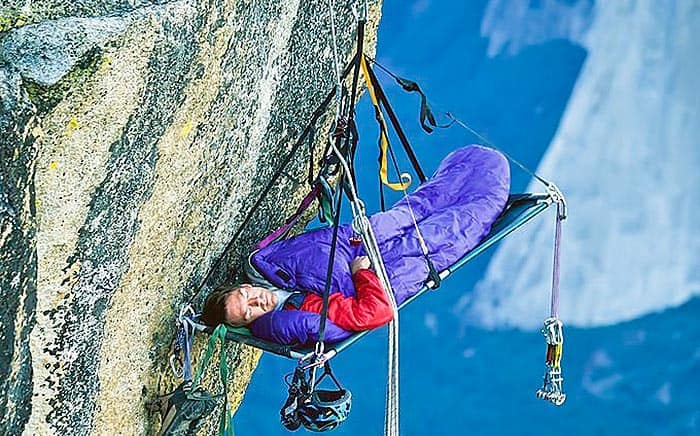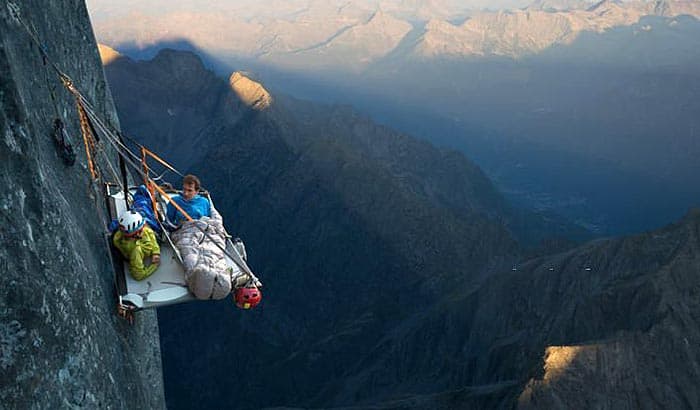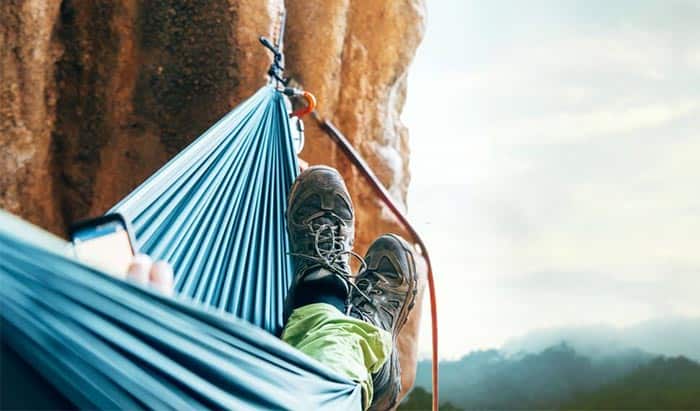Have you wondered, “How do rock climbers sleep while attempting to climb a challenging wall?” Many large walls call for multi-day treks; climbers are forced to spend the night on cliffs. As a result, they require special equipment to keep safe.
Contents
How Do Rock Climbers Sleep? They Use Portaledges
Sleeping on a rock ledge is a regular procedure for serious rock climbers on multi day expeditions. But bringing your own is the next best option if there isn’t a nearby natural ledge. During a climb, climbers might set up a bed or storm shelter for themselves using portable ledges, also known as portaledges.
The safest and most common way to camp while climbing multi-pitch large wall routes is on portaledges. Anyone considering sleeping on an open-air cot hundreds of feet above the ground is sure to feel uneasy. So let’s examine a portaledge’s definition and operation in more detail.
What is a Portaledge?
A portaledge is a foldable, portable bed used for perching on vertical surfaces, like the cliff wall. A portaledge is a platform covered in fabric with a metal frame, similar to the hanging cots used in camping trailers. The frame is solid enough to sleep and even stand on, and you can assemble it while leaning against a rock ledge.
Portaledges provide climbers with a secure sleeping area and use them as a storm shelter. In this instance, the portaledge is covered during rain or storms by a rain fly resembling a tent’s outer layer. Vertical camping is the practice of using the portaledge as a hanging tent once the rain fly is attached.
Most portable ledges weigh ten to thirteen pounds, although they can weigh up to 28 pounds. The size requirements and priorities of the climber determine the kind of portaledge selected for an adventure. One or two persons can sleep comfortably on a portaledge. Loops are frequently stitched into the straps to hold additional stuff and increase sleeping space.
How Does a Portaledge Work?
The portaledge is a straightforward design resembling a cot, made of a metal tube frame (often aluminum). To create the bed, fabric (usually nylon) is spread over the tubing. Portaledges are supported by four- or six-point suspensions and only need a single anchor.
These straps are fastened to the four corners and (for six-point suspensions) the middle of the sides of the metal frame, spreading out from a central hanging point. In the end, it exactly resembles a hanging tent.
Different anchor points and bolts are often positioned along massive wall pathways for portaledge use. You have probably discovered a spot intended for vertical camping if you discover a bolt off the beaten path.
How to Set Up a Portaledge
Here’s how to assemble a portaledge for a safe night high up on a rock.
Step 1: Assemble the Frame
When you’ve located where you want to set up, spread out the portaledge and check to ensure the straps are not twisted. Starting with the wall side, join the frame components together. Make sure to firmly fix the corners as you assemble the other frame parts.
To help reduce any tension on the corners, if necessary, try scrunching the material into the center of the frame. Make that the spreader bar in the center of your portaledge is positioned correctly and firmly.
Step 2: Setting the Fabric
After assembling the frame, use the relevant straps to pull the fabric taut. To maintain consistent tension throughout, adjust gradually and evenly.
To prevent one side from lifting under the tension of the fabric, it is crucial to maintain a flat frame throughout this process. The ideal portaledge should be rigid and flat.
To keep the ledge steady, check that the adjustable suspension straps are roughly the same length near the bolt. As long as feasible, the straps should be in place. This will give you, your gear, and anyone else engaging in vertical camping the most space possible.
It is preferable to set up the rain fly at the same time you set up your portaledge if rain is expected or if you like to be prepared. The rainfly is designed to quickly deploy and install between the anchor and main locking carabiner.
Always ensure you’re securely fastened to the anchor bolt to guarantee your safety.
Step 2: Secure the Center Divider
A central divider is a common feature of portaledges. The middle division should be fastened and pulled taut when you’re ready to go to sleep. This will maintain the sleeping area’s comfort and flatness throughout the night.
Although it may be unsettling to sleep perilously close to a cliff’s edge, as long as your rope and harness are fastened to an anchor bolt, you are entirely secure.
When is Sleeping on a Portaledge Necessary?
For seasoned climbers, cliff camping, also known as vertical camping, is a widespread practice. An avid rock climber may spend several days scaling vertical rock faces. Thus they require plenty of downtime for rest, meals, and sleep in between ascents.
Famous rock climbers like Alex Honnold exaggerate how simple large walls appear. Honnold is renowned for finishing a large wall in a short time, although most rock climbers need several days to complete the same route.
Many rock climbers must rest between ascents if they can’t complete a climb within a day. Some climbers choose to spread out their ascent and only go halfway or a third of the way. It largely depends on an individual climber’s performance and preferences on how long or how many days they spend on a tall wall.
How Do Rock Climbers Sleep Safely: Tips and Tricks
No concerns if this is your first time using a portaledge. First, practice pitching a tent on a tree safely elevated above the ground. It will be simpler to set up and utilize in real-time the more comfortable you are with your portaledge. In particular, if this is your first time climbing, you should go with an experienced climber.
Before it becomes dark, be careful to set up your hanging cot. The ideal climbing partner is preferable, although it’s not required. One person can set up a portaledge. The objective is to put it together as steadily, evenly, and firmly as possible.
It’s best to let your partner know when you’re shifting your weight or pulling away from the portaledge if you’re with them to prevent a pleasant shock from the sudden movement. To ensure comfort and ease of sleep, ensure everything is set up correctly.
Conclusion
Rock climbers like living on the edge. But to do so, they often need to sleep on the edge, too, quite literally. When no natural ledge is around for rock climbers’ safe usage, they must rely on other methods.
How do rock climbers sleep? They use the safe, light, and easy-to-use portaledge. With just a bit of practice, you can safely sleep on a high wall, too!



